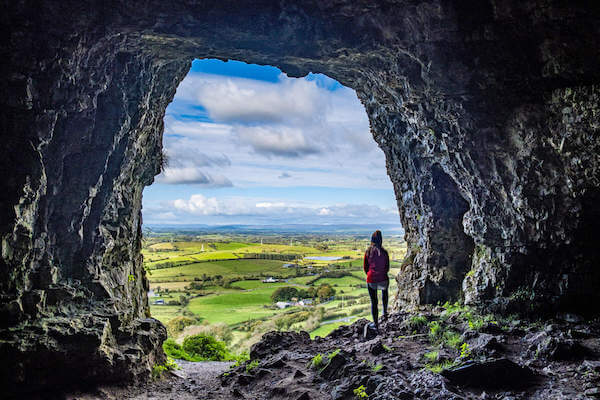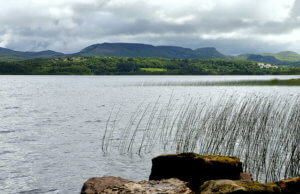Are you planning on spending a week in County Sligo?
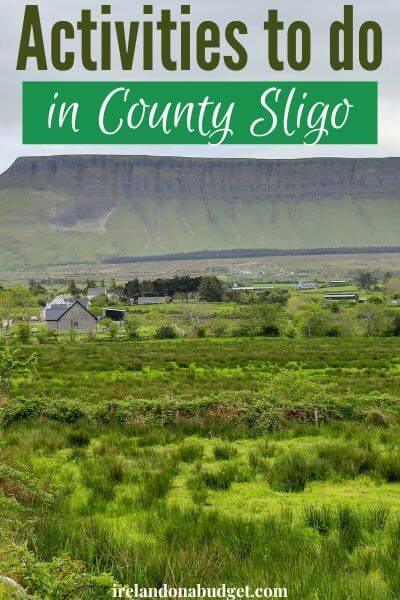 This blog post contains affiliate links, and I may earn compensation when you click on the links at no additional cost to you.
This blog post contains affiliate links, and I may earn compensation when you click on the links at no additional cost to you.
If you love the great outdoors, are up for a Wild Atlantic Way adventure, or you’re simply drawn to the places in Sligo that William Butler Yeats got so much of his inspiration from, then spending a week in County Sligo will satisfy all of that and more.
Here are 5 ways you can enjoy this heavenly slice of Northwest Ireland.
1. WALKING/HIKING IN COUNTY SLIGO
The Queen Maeve Trail
There’s no shortage of walking routes to take in Sligo.
Perhaps the most intriguing — and might I say the most popular — is the Queen Maeve Trail.
Like so many attractions in Ireland, this one is also shrouded in legend.
Irish folklore tells us that Queen Maeve, the Queen of Connacht, is buried underneath a large cairn at the top.
Experts are not sure if Maeve even existed, but judging by the number of earthen banks, passage tombs, and other ancient remains located close to the famous landmark, I’d say there’s a good chance that she may have and that she was buried here as part of an ancient burial ritual.
Getting to the top of Knocknarea will take you about 2 hours or so.
There are three ways of accessing the 6-kilometer (3.7 miles) loop, including the Glen Road car park on Route L3507, from the R292 on Strandhill Road, or from Route L3503 at the Rathcarrick car park.
I suggest taking the Rathcarrick Wood route as it just seems prettier (you’ll see from the video below).
At the top, stay awhile and enjoy the fabulous views of County Sligo as well as neighboring Counties Mayo and Donegal.
Be sure to bring plenty of water and snacks and wear the proper footwear and clothing before taking off.
Stay in a B&B in County Sligo. Just click on the form below.
The Gleniff Horseshoe Drive
Otherwise known as the Benwisken Trail, this 10-kilometer (6 miles) walk is more moderate and winds through quiet country roads, with fabulous views of the Dartry Mountains and the chance to see up close the scale and beauty of County Sligo.
While hikers will want to do this one on foot (great during the summer months if the weather is dry and you are up for a 5 1/2 -hour trek), others may want to drive (that journey is about 30 minutes).
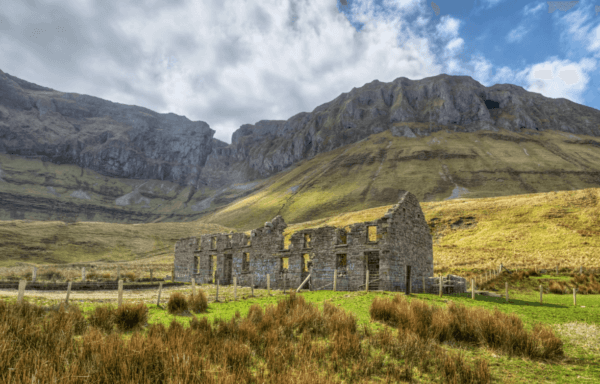
Head for the village of Cliffoney, about 13 miles/22 km north of Sligo town, and look for a sign that says “Yeats County Gleniff Horseshoe.”
The old 19th-century Barytes Mill is the first stop on the route, a popular spot for photographers and others visiting the area. Following that, you’ll see Diarmuid and Grainne’s cave, the highest in Ireland.
Don’t be tempted to climb to the cave unless you are an experienced hiker.
The Keash Hill Trail
Several legendary tales have contributed to the story of the Caves of Keash located on the western side of Keshcorran Mountain in County Sligo.
One of them is the story of Cormac Mac Art, once a High King of Ireland and who was believed to have been born close to a well beneath the caves.
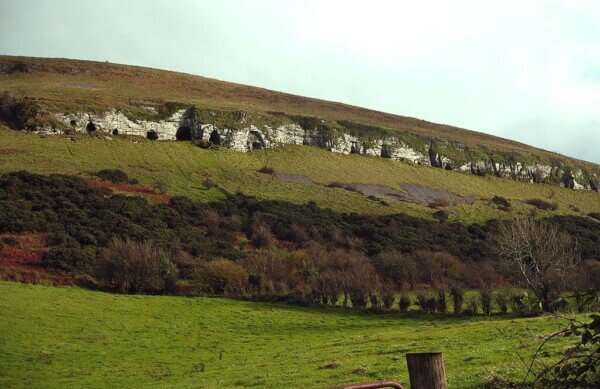
The limestone caves are believed to be at least 12,000 years old, pre-dating the Egyptian Pyramids, with the remains of hares, brown bears, red deer, and Arctic lemming discovered there by local archaeologists.
The 3.4-kilometer (2 miles) Keash Hill Trail begins at the car park near the Roman Catholic church in the village of Keash.
Hazelwood Forest Walk
There are a number of woodland walks you can take in County Sligo, but my favorite one is the Hazelwood Forest Walk, an easy trek that is only 5 kilometers (3 miles) from Sligo town.
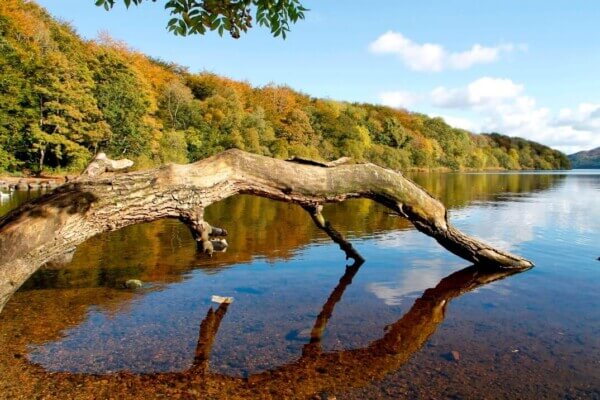
The route follows Lough Gill’s shore, with a number of wooden sculptures to enjoy along the way. Be sure to bring a picnic lunch and soak in the stunning lakeside views.
By clicking on the Amazon link below, I may earn a small commission from the Amazon Associates Program, but only if you decide to buy something on the site. However, you will not incur any additional costs by doing so.
Lough Gill was the Sligo lake immortalized in Yeats’s poem, The Lake Isle of Innisfree, which you'll find in The Collected Poems of W.B. Yeats.
Other similar walks in Sligo can be found on the Sligo Walks website.
Compare Car Rental Prices for Your County Sligo Adventure with Discover Cars
2. WATER ADVENTURES IN COUNTY SLIGO
Sligo is known as a surfing destination.
However, if you’re interested in other water sports like kayaking, windsurfing, or kite surfing, you’ll find there are plenty of opportunities for that in different parts of the county.
Kayaking
Choose between a guided kayaking tour of Sligo’s coastal estuaries or of its tranquil lakes.
Both are run by Sligo Kayak Tours.
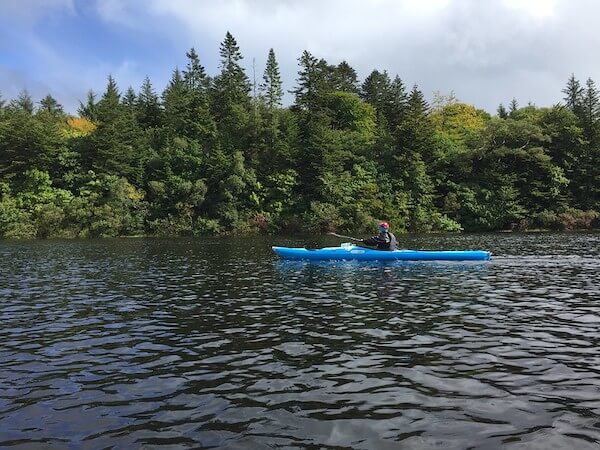
With a nod to sustainability, the popular tour company keeps its tours small and personal.
You can choose from a kayak tour on Lough Gill, Glencar Lake, Ballisodare Bay’s seal colony, or around Dernish Island.
West Coast Kayaking is more for the adventure seeker. Choose between river, sea, or lake kayaking.
Find Top Sligo On the Water Tours
Surfing
Sligo is called the “Surf Coast of the Wild Atlantic Way,” and for good reason. In Mullaghmore alone, waves can go as high as 50 feet (15 meters) and above.
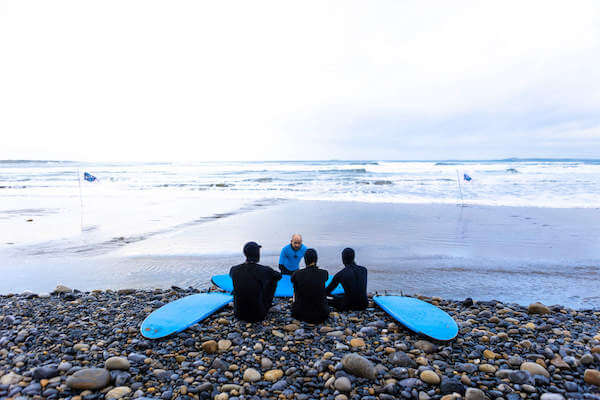
If you just want to learn the basics of surfing during your week in Sligo, it’s totally doable. In fact, if you’ve got kids with you, surfing is the perfect summertime activity in Ireland.
Surfing schools are located along the Sligo coast.
The popular ones include Sligo Surf Experience, the Strandhill Surf School, 7th Wave Surf School, and the North West Surf School.
You can also enjoy other water-based activities like SUPing (Stand Up Paddling) with North West Adventure Tours.
Boat Tours
If you find yourself in Enniscrone, a pretty seaside town that's about 10 miles from Ballina, Co. Mayo, you might want to take an adventure on the ocean with Enniscrone Boat Tours.

You can take 1 or 2-hour tours or if you're feeling more adventurous and want to experience Ireland's beautiful Wild Atlantic Way coastline, then a half-day or full-day tour is recommended.
Enniscrone Boat Tours take passengers as far as Downpatrick Head to see the famous Dun Briste sea stack, or if you wish, you can head north along the Sligo coastline toward Donegal.
Find a Vacation Cottage in County Sligo with Vrbo
3. SLIGO’S ARCHAEOLOGICAL SITES
Carrowmore Megalithic Site
Most first-time visitors to Ireland have no idea that there are other significant archaeological sites besides Newgrange in County Meath.
The Carrowmore Megalithic Site should be on your bucket list if you are interested in spending a week in County Sligo and you want to gain a greater understanding of the ancient history that has shaped this part of Ireland.
The site, about 6,000 years old, contains the oldest collection of stone circles and dolmens in the country. It is about 2.5 miles (5km) from Sligo town.
There are about 30 monuments to see here, including the Kissing Stone, among the best preserved of Carrowmore’s monuments.
There is also a small visitor center on the site that contains a wonderful exhibition of information related to Sligo’s megalithic treasures. It is open daily from 10 a.m. through 5 p.m.
You can do your own self-guided tour, but I recommend taking a guided tour for only €5.
Read More: Prehistoric Rock Art Found on Sligo Tomb
The Carrowkeel Megalithic Site
The Carrowkeel Megalithic Site is about a half hour’s drive from Carrowmore and is equally impressive, containing a series of passage tombs and hilltop cairns that are at least 5,000 years old.

The best way to get to the site from Sligo town is to take the N4 dual carriageway to Castlebaldwin and then follow the signs for Carrowkeel.
Be prepared for a 20-minute walk from the car park.
4. ACTIVITIES FOR YEATS LOVERS
Below you'll find information on some of the attractions in Sligo that are closely linked with William Butler Yeats. A new Yeats Trail includes even more.
Drumcliff – The Final Resting Place of Yeats
Yeats was not living in Ireland at the time of his death.
His final wish was to be buried in Ireland but not until he was first interred in a cemetery in Menton, France.
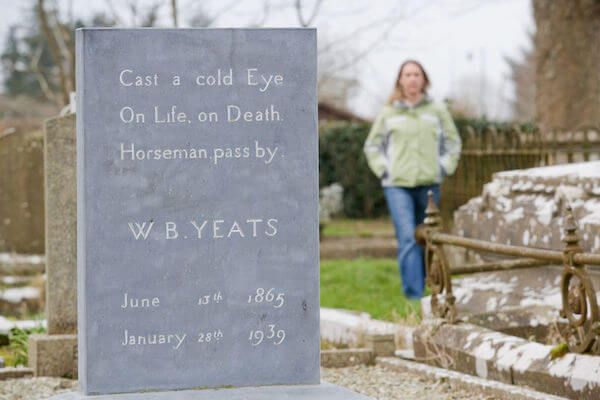
The logic for this strange request was to avoid media attention.
That didn’t work of course because, by the time Yeats was reinterred at St. Columba’s Church of Ireland cemetery in Drumcliff in September of 1948 (9 years after his death), it was a major news event all over Ireland.
You will find his grave about 4.6 miles (7 km) from Sligo town. It’s no coincidence that he was laid to rest there since his paternal great-grandfather, John Butler Yeats, served as the church’s rector.
After stopping for a while at his humble tombstone, you can grab a beverage at the nearby coffee shop and some souvenirs at thecraft shop.
Get Wifi in Ireland with Wifi Candy – take 10% off with code IOB2024
Lissadell House & Gardens
Lissadell House & Gardens is the place where Yeats spent a lot of time when visiting Sligo.
Located on the Magherow Peninsula, north of Sligo town, Lissadell House is in many ways a shrine to the relationship that Yeats had with the Gore-Booth family, including Constance Gore-Booth (later known as Constance Markevicz), the eldest of the two daughters of a wealthy Protestant landowner.
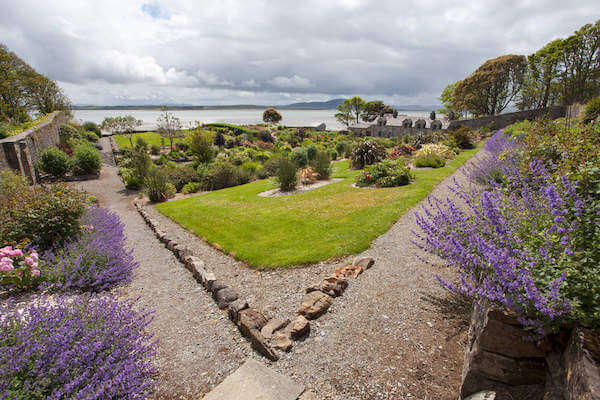
Yeats even immortalized the house and the girls in his poem, “In Memory of Eva Gore-Booth and Con Markiewicz.”
Guided tours of the house are available at 11 a.m., 12 noon, 1.30 p.m., 2.30.p.m., 3.30 p.m., and 4.30 p.m. during the summer season.
Tickets should be booked online. They include entrance to the house and formal gardens.
Be sure to visit the Coach House where you’ll find an interesting exhibition on the Easter Rising of 1916, including photographs of the aftermath of the event, and plans for the Rising in the form of a manuscript written by Markevicz, among other memorabilia.
Glencar Waterfall
While this waterfall is actually in County Leitrim (a short drive away), there is a firm connection with Yeats here too.
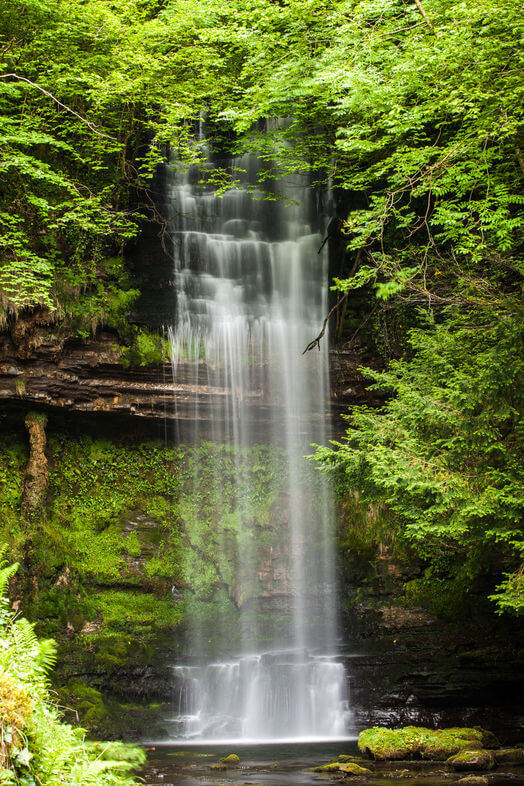
In his poem, “The Stolen Child,” Yeats writes: “Where the wandering water gushes / From the hills above Glen-Car / In pools among the rushes / That scarce could bathe a star,” referring to the waterfall and the nearby Glencar Lough.
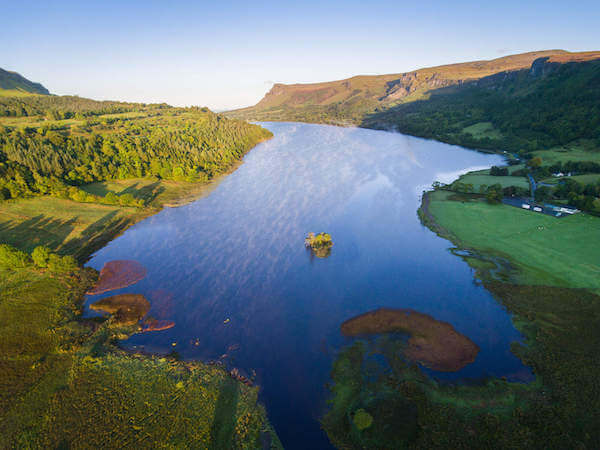
While you’re there, take the Waterfall Walk, a 16-minute trek that will take you on a paved pathway with a staircase at the top. Enjoy the views of the lake and surrounding area from the top. Dogs are not allowed on this trail.
5. EXPLORING SLIGO TOWN
Sligo Abbey
Situated in the center of town, Sligo Abbey is worth a stop if only to learn more about Sligo during the Middle Ages.
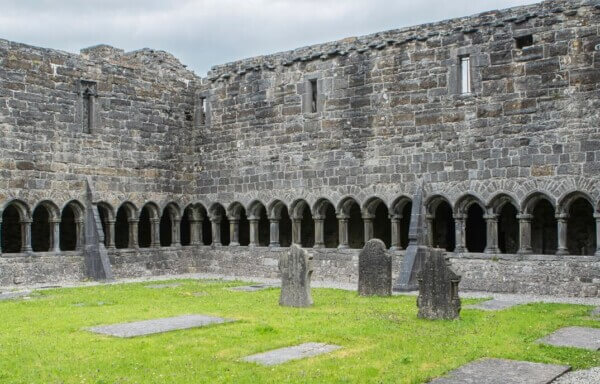
The abbey was established by Maurice Fitzgerald, the founder of Sligo town. Through good times and bad, it is still standing, like many similar abbeys across Ireland.
Perhaps what’s most notable about this one is its sculptured 15th-century high altar, the only one to survive in an Irish monastic building.
The abbey is open from March through October. Guided tours are available.
Sligo Museum
This small yet interesting museum is worth visiting if you have time while spending a week in Sligo.

Some of the museum’s interesting artifacts include a collection of Yeats’s poems from 1880 through 1936 as well as paintings from his brother Jack B. Yeats. A preserved piece of bog butter is also on display.
Read More: Little-Known Museums in Ireland Worth Visiting
The Dracula Connection to Sligo
You may not know it but Bram Stoker’s mother was born in Sligo and many of her stories from the 1832 cholera outbreak in the town contributed to Stoker’s famous novel, “Dracula.”
To find out more, take Sligo’s Dark Tales Tour.
Sligo Food Tour
In recent years, Sligo has earned the reputation as a place to find great-tasting food.
The Sligo Food Tour is the perfect way to taste some of the town’s culinary delights.

Spend 2 ½ hours sampling cuisine from a selection of Sligo’s best restaurants led by local restaurateur Anthony Gray, the owner of Eala Bhan and Hooked.
Below is a Google map of some of the places mentioned above.
Read More: County Sligo: The Ultimate Road Trip
Additional activities that you might enjoy in County Sligo include golfing on the region's fine golf courses. Consider the Rosses Point Golf Course (formally known as the County Sligo Golf Club), Enniscrone Golf Course, the Strandhill Golf Club, and the golf club at Castle Dargan (stay and play rates are available on the hotel's website – €179 per night until Nov. 2022)
Rates at the above County Sligo golf courses range from €205 in green fees to a very affordable €30 at the Strandhill course.
Is spending a week in County Sligo on your Ireland vacation itinerary? Let me know in the comments below.

